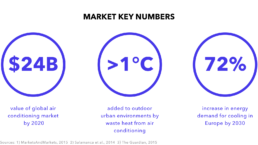As the planet warms and populations become increasingly urbanised, the demand for cooling is on the rise, but existing technology is outdated and heavily polluting. With the increasing need to reduce carbon emissions, this growing market presents more and more opportunities to reduce the need for cooling and make cooling efficient.
Today, air conditioning (AC) and refrigeration accounts for as much as 17% of global electricity demand, and in the US alone, AC units lead to the emission of 117 million tons of carbon annually. While air-cooling systems have become more efficient over time, they still use significant power, placing huge demand on electricity grids at peak times. In addition, AC systems typically emit fluorinated gases, which have global warming potential many times higher than CO2. In cities, AC can raise temperatures by more than 1°C locally, worsening the heat island effect. This vicious cycle means that keeping cool is making us hotter.
The growing demand for cooling, which is expected to overtake the global demand for heat by 2060, can be attributed primarily to a growing middle class, living in hot urban environments, where AC in buildings and cars is a necessity.
New innovations such as solar-thermal technology, which uses solar heat to cool buildings, consumes 30% to 90% less electricity than conventional AC. New research indicates that adding improved efficiency in refrigeration and phasing out fluorinated gases used for cooling could eliminate a full 1°C of warming by 2100. Emissions equivalent to 89.7 gigatons of CO2 could be avoided via better management of refrigerants already in circulation. Despite a high economic cost, this signals the importance of substituting fluorinated gases, increasing efficiency, and innovating new solutions to keeping cool

Products and Services
Solar cooling systems are becoming more widespread at all scales, and some cities, such as Vienna and Copenhagen, are installing district cooling systems that vastly improve efficiency. Across commercial facilities in the United States, thermal storage solutions are being used to shift peak demand loads, allowing cooling to be produced at less than half the cost and reducing carbon emissions by up to 96%.
With the exponential growth in demand for data storage, data centres are a quickly growing market that require masses of cooling. The strategic positioning of such facilities and other commercial spaces near cool bodies of air and water that can exchange heat is driving new solutions.
In urban settings, design is playing a growing role in reducing the need for expensive cooling systems. In India, where cooling accounts for 40% of electricity demand in some cities, products are coming to market that mimic plants’ natural evaporation processes to cool spaces with minimal energy input.

Market Size and Demand Drivers
The value of the global AC market is forecast to exceed $24 billion by 2020, and 1.6 billion new units are expected to be sold by 2050. Even today, more than 60 million air conditioners are sold in China each year. The data centre cooling market alone is expected to grow to more than $14 billion by 2021 at a CAGR of 15%.
As the global middle class expands and moves into urban areas that are becoming warmer due to climate change, the demand for innovative cooling solutions that deliver on the triple bottom line increases by the day.
This market featured in the 2018 Global Opportunity Report.

